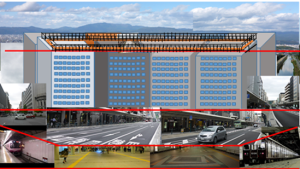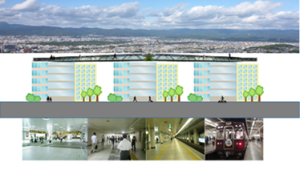Is a 10,000 yen tourist tax high or low? ≪3≫ ~How to use the tourist tax, the creation of the Okoshiyasu Program, and new tourism proposals Creation of the Heian Sky Corridor (Welcome Program) ~
Yoshie Doi
I would like to propose a new approach to urban development in Kyoto City, dividing the space into different heights. The entrance to a department store in Kyoto may become an “air corridor Heiankyo view gate.
- An underground space with access to JR, subway, Hankyu, and Keihan
- An underground commercial space aimed at expanding the underground shopping district
- A walking town space on the ground
- A business space up to 60 meters high where economic activities take place
- How about making Kyoto’s slogan an initiative that takes into consideration landscape administration, such as establishing the Heian Sky Corridor on the rooftops of buildings that is 3.3 km long and allows visitors to enjoy the scenery of the mountains on three sides, unchanged since the Heian-kyo period, above the 60-meter height limit?
 |
 |
View from the Heian Corridor, Higashiyama, Kitayama, Nishiyama, Kamogawa River, Katsura River Economic activity, science and technology, living space Ground Underground space, underground shopping street, subway, private railway |
|
Skywalks around Kyoto Station Building and Shijo
Unfortunately, the mountains cannot be seen from the rooftops of the department stores Daimaru and Fujii Daimaru. This is because of obstacles. The mountains can be seen slightly to the northeast from the rooftop of Takashimaya. The building with a view of the mountains in the Shijo area is Hotel Monterey Kyoto (Karasuma Sanjo Sagaru). The spa lounge on the top floor (13th floor) is a rare spot in the city for the Gozan no Okuribi fires, as there are no obstacles to the north. Kyoto Station Building also has a view of the entire mountain.
We would like to find building owners who will cooperate with the Heian Skywalk and make it a reality.
This time, we proposed a future urban landscape. From the next issue, we will be presenting proposals unique to Kyoto.
(Continued in the next issue)
The end of document
Translated by Masami Otani
